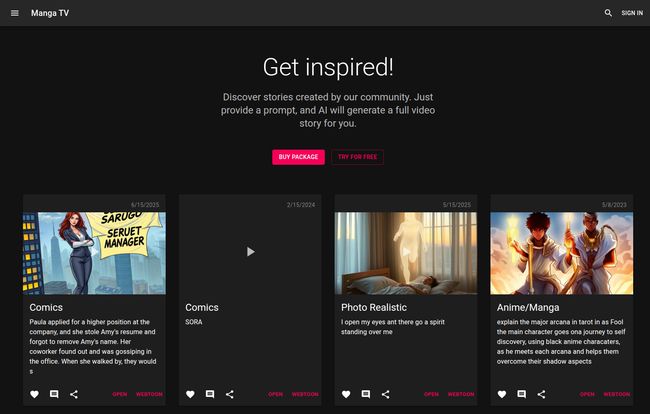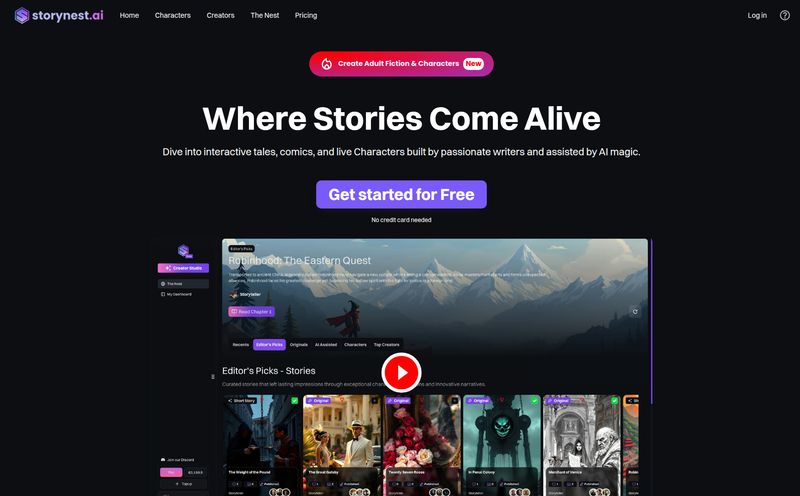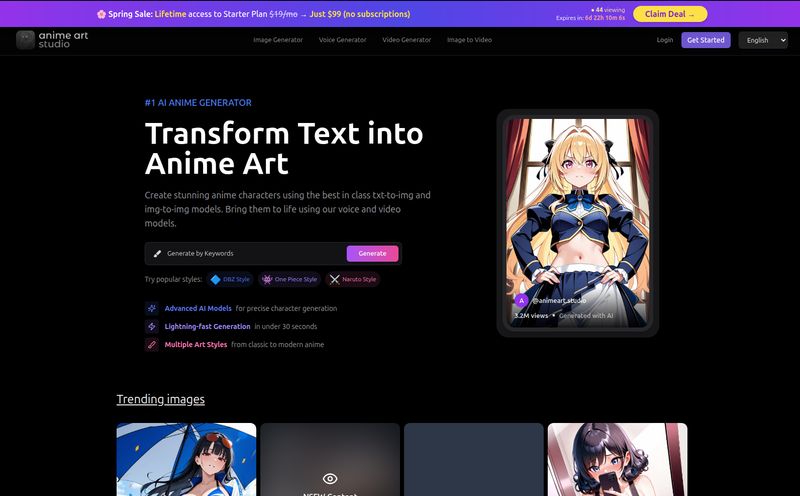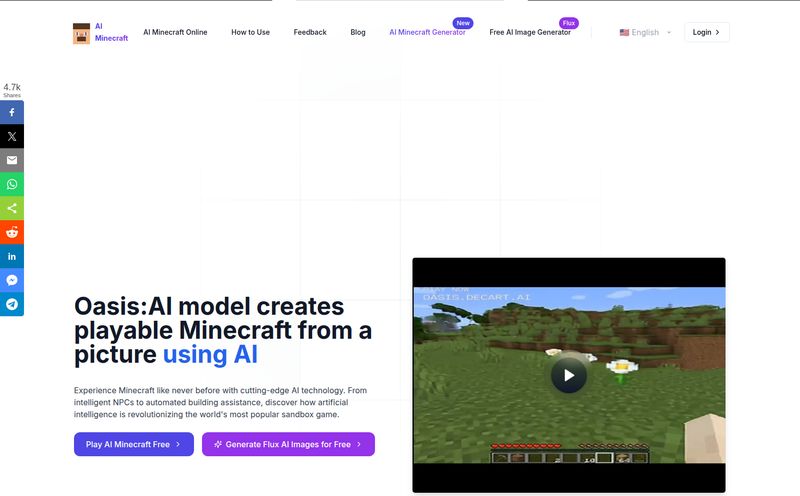I've had a thousand comic book ideas. No, really. Since I was a kid, my notebooks have been filled with terrible drawings and grand ideas for epic sagas. The problem? I can't draw. Not a stick figure, not a straight line. My artistic talent is, to put it mildly, non-existent. For years, that meant my ideas stayed locked away in those notebooks. The cost and skill required to hire an artist or learn animation felt like a mountain I couldn't climb.
Then AI art generators came along, and suddenly, things got interesting. We've all played with Midjourney, creating stunning single images. But a story? A full narrative with panels, pacing, and sound? That was still the hard part. Until I stumbled upon a tool that genuinely made me stop and say, 'wait, what?'
It's called Manga TV, and it doesn't just generate a picture. It promises to generate a whole video story, a mini-comic complete with sound and music, from a single prompt. It's a bold claim. So, of course, I had to see if it was just another gimmick or the real deal.
So, What is Manga TV Anyway?
At its core, Manga TV is an AI-powered comics generator. You feed it a text prompt—a story idea, a scene, a character description—and its system goes to work. It uses a combination of large language models (like GPT) to write the story and image generation models (like Stable Diffusion) to create the visuals. It then stitches everything together into a 2-3 minute video, complete with panel transitions, music, and even voice-over in different languages. Think of it as a digital storyboarding assistant on hyperdrive.
The whole idea is to take the friction out of creation. You don't need to be a writer, an artist, or a video editor. You just need an idea. The platform even has options for vertical videos, making it a potentially powerful tool for creating unique #Shorts or TikTok content.

Visit Manga TV
My First Impressions and a Quick Walkthrough
Jumping into the platform, the first thing I noticed was the community gallery. It's a wall of creations from other users, and honestly, it’s the perfect starting point. You see a huge range of styles, from classic 'Comics' and 'Anime/Manga' to wilder stuff like 'Lego' and even 'Photo Realistic'. Seeing a story about a lonely Pokemon next to a noir thriller about a sad-sack detective immediately tells you this isn't a one-trick pony.
The process itself feels almost too simple. You write your prompt, and you let the AI cook. The magic is in turning a simple sentence like, "A grizzled space marine discovers a lost kitten on an abandoned freighter," into a multi-panel video story. It's not just generating a single image of the marine and the kitten; it's creating a sequence. The discovery, the reaction, the first interaction. It’s pretty wild to watch.
The Standout Features That Caught My Eye
From a Single Prompt to a Full Video Story
This is the main event. The ability to generate a complete narrative arc, however short, from one input is the core appeal. I've spent hours trying to get consistent characters and scenes out of other AI tools. Manga TV automates that whole frustrating process. While the results can sometimes be a bit quirky—AI still has its moments, you know?—the sheer speed from idea to finished product is something else. It's a fantastic tool for rapid prototyping stories or creating B-roll for a bigger project.
So Many Styles, So Little Time
The visual versatility is a huge plus. You're not locked into one default 'AI' look. Want a gritty, dark comic book vibe? Done. Want a bright, clean anime style? Easy. This flexibility means you can tailor the output to your specific need, whether it's a funny skit for social media or a more serious proof-of-concept for a story. You can even customize characters and backgrounds to get a bit more control over the final output.
More Than Just Pictures: Audio and Music
A silent comic is one thing, but Manga TV adds another layer with sound. It integrates music and can generate voice-overs in major languages. The paid tiers even give you access to higher-quality voices from services like WaveNet and ElevenLabs, which are some of the best in the business. This transforms a simple slideshow into a genuine multimedia experience, saving you yet another step in the production process.
Let's Talk Money: The Manga TV Pricing Model
Okay, this is where I got really interested. In a world dominated by monthly subscriptions that slowly drain your bank account, Manga TV does something wonderfully old-school: one-time payments. You buy a bundle of video minutes, and you use them when you want. No recurring fees. Hallelujah.
Here's a quick breakdown of their pricing structure:
| Plan | Price | Video Time | Key Features |
|---|---|---|---|
| Free | $0 | 5 mins total + 2 free mins/day | Basic Styles, Standard Voices, GPT-3.5, Public Content |
| Bronze | $9.99 | 1.5 hours | One-time payment, Custom Styles, WaveNet Voices, Royalty-free videos |
| Silver | $24.99 | 5 hours | One-time payment, OpenAI/ElevenLabs Voices, GPT-4/Claude, SD 3, Royalty-free |
| Gold | $99.99 | 25 hours | One-time payment, All top-tier models and voices, Royalty-free |
The Free plan is generous enough to let you properly test the waters. The Bronze plan is perfect for a one-off project or just to have some fun. In my opinion, the Silver plan hits the sweet spot for serious creators, giving you access to the best AI models (GPT-4 and SD 3 make a difference) and a solid chunk of video time for less than the price of a few fancy coffees.
The Good, The Bad, and The AI
No tool is perfect, especially in the fast-moving world of AI. It’s important to have a balanced view.
What I Loved
The ease of use is off the charts. The no-subscription pricing model is a massive win and feels incredibly user-friendly. I also love the 'all-in-one' nature of it. Not having to jump between a scriptwriter, an image generator, a video editor, and a sound library is a game-changer for solo creators or small teams. The sheer speed of creation is its biggest strength.
Where It Could Improve
Let's be real, you're trading some creative control for convenience. This isn't like meticulously drawing every panel yourself. The AI can sometimes interpret prompts in weird ways, and the quality can vary. Sometimes you get gold, sometimes you get... something a little strange. The free plan's availability also depends on server load, so during peak times, you might have to wait. It's a fair trade-off for a free service, but something to be aware off.
Who Is Manga TV Actually For?
After playing around with it, I can see a few groups getting a ton of value here.
- Content Creators & Marketers: Need a quirky, eye-catching video for Instagram Reels, YouTube Shorts, or TikTok? This is a ridiculously fast way to generate unique content.
- Writers & Storytellers: Want to visualize a scene from your novel or script without hiring an artist? This is an amazing tool for creating visual storyboards or proofs-of-concept.
- Hobbyists & Tinkerers: If you just love playing with new AI tools and have a bunch of fun ideas, the free and bronze tiers are perfect for experimenting.
- Educators: Imagine creating short, animated videos to explain a concept in a more engaging way. The potential here is huge.
Frequently Asked Questions (FAQ)
- Is Manga TV free to use?
- Yes! There is a free plan that includes 5 minutes of video to start and gives you an additional 2 free minutes every day. It's a great way to try out the core features.
- Do I need to subscribe to Manga TV?
- Nope! And this is one of its best features. Manga TV operates on one-time payments. You buy a package of minutes and use them as you see fit, with no recurring monthly charges.
- What kind of video quality can I expect?
- The quality depends on your prompt's complexity and the plan you choose. The paid plans, which use more advanced models like Stable Diffusion 3 and GPT-4, generally produce higher-quality and more coherent results than the free tier.
- Can I use the videos I create commercially?
- According to their pricing page, the paid plans (Bronze, Silver, and Gold) come with "Royalty free videos," which typically means you can use them for commercial purposes. It's always best to check their most current terms of service, though.
- What AI models does Manga TV use?
- It uses a stack of them! For text, it can use GPT-3.5, GPT-4, and Claude. For visuals, it uses various versions of Stable Diffusion, including SD XL and SD 3, as well as SVD 1.1 for video aspects.
- Can I customize my characters?
- Yes, the platform offers options to customize characters and backgrounds, giving you more granular control over the final video than a simple prompt-only system.
Final Thoughts: A New Tool in the Creator's Arsenal
Manga TV isn't going to replace professional animators or comic book artists. Let's get that straight. But that's not its goal. What it does, and does surprisingly well, is democratize video storytelling. It lowers the barrier to entry to almost zero.
It’s for the person with a great idea but none of the traditional skills. It's a tool for rapid ideation, for social media content that stands out, and for just having a bit of fun. The one-time payment model alone makes it worth a look in my book. If you've ever had an idea for a story you wished you could see, go give their free plan a shot. You might be surprised at what your words can become.



